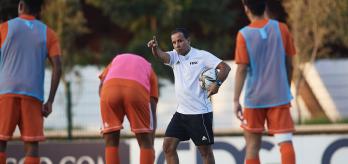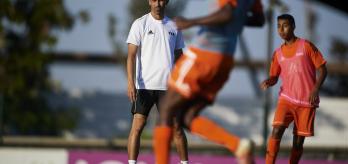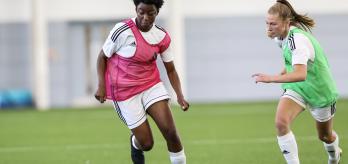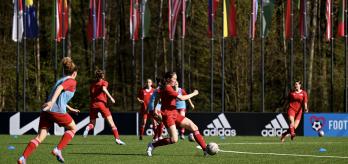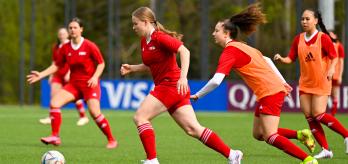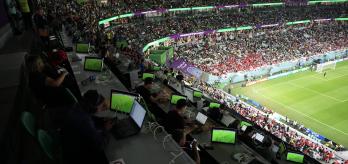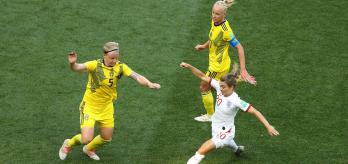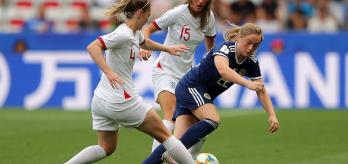These exercises are designed for a team to hone their response to losing the ball and their ability to regain it – as quickly and as high up the field as possible.
As demonstrated in the following clips, regaining possession high up the pitch in areas close to the opposition goal can lead to dangerous goalscoring opportunities.
Session overview
- Part 1: General practice
- Part 2: High-intensity practice - 4v4
- Part 3: Game-related practice - 9v9
Key learnings
Players must react immediately after losing possession, and these drills will help them practise several key actions: press, cover, balance, shadow-cover. As well as their capacity to counter-press quickly on the transition to defence, they will also work on how they secure possession once they have won it back.
Organisation
- Player numbers: 16 outfield players plus 2 goalkeepers.
- Age group: 12 and above.
- Skill level: for developing players up to elite level, with the coach managing the difficulty and intricacies of the session.
PART 1: GENERAL PRACTICE
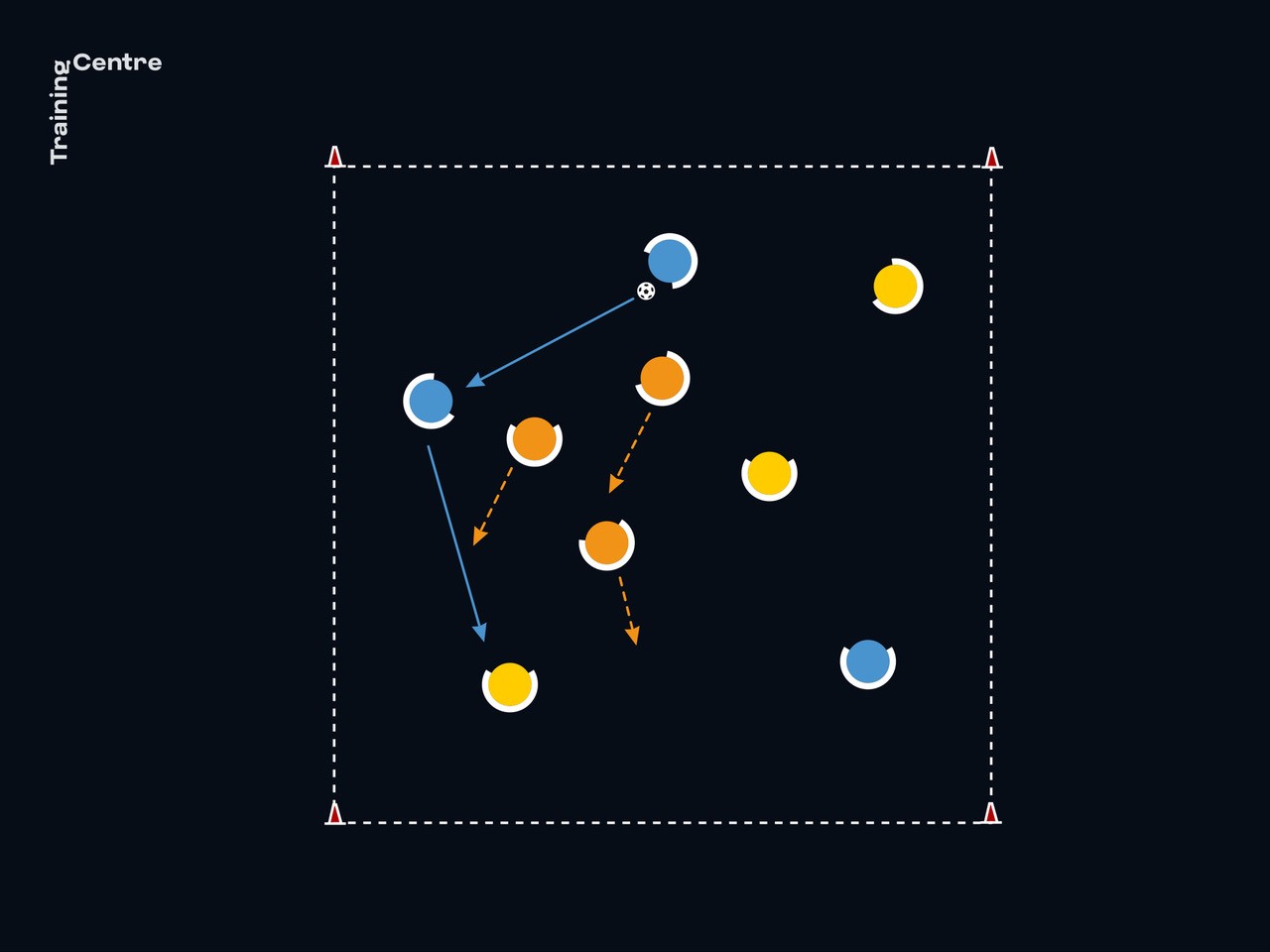
This is an exercise aimed at improving how players react to losing the ball. They will work with team-mates on pressing, covering space and anticipating as they seek to achieve a swift regain.
-
9 players in 3 teams of 3
-
An area of the pitch sized 14m x 14m
-
The practice takes the form of 3 v 3 + 3 and comprises 5 x 90-second blocks of play with 30 seconds' recovery between each block.
-
Players play 3 v 3 + 3 in a possession drill, but the focus is on counter-pressing. The possession team who lose the ball transition to become the defenders and work in a triangle to try to win it back. The closest player applies intense, aggressive pressure and their two colleagues look to control the spaces around the ball and anticipate a pass between opponents.
-
From the player closest to the ball, there must be total effort in the press. One player can always defend two opposition players by blocking the line, pressing the ball carrier, and checking over the shoulder.
-
A coach can set challenges, such as the following:
-
In possession, try to play on two seconds in possession.
-
Ten consecutive passes give the two possession teams a goal
-
The defending team score two goals when they win the ball back and secure possession (team-mate receives a pass).
-
After losing the ball and becoming a defending team, you can score two goals by winning the ball back in six seconds.
-
-
To maintain the focus of players, it can help to have a league table, with each team of three keeping their own score. Meanwhile, for a coach working with extra players, they can increase the area size and the numbers per team. If working with odd numbers, the options could be to have a neutral player or target players.
-
The reaction to the loss of possession is vital and this means the coach will want to see quick counter-pressing on transition.
-
Forcing the opponents on to their weaker foot. The angle of approach is important when pressing and players should try to keep play on one side, making the pitch small and using the sideline as a defender.
-
The coach will also want to see players playing away from pressure and thereby securing possession once they have won the ball back.
PART 2: HIGH-INTENSITY PRACTICE – 4v4
The aim of this session is to develop counter-pressing, improving players' pressing reaction the moment they give it away. It will help them develop the habit of hunting the ball back high straight away. This will make them more effective at winning the ball back high up the pitch.
-
The practice takes place in a 35m x 40m area.
-
Total of 18 players: 2 teams of 8 outfield players plus 2 goalkeepers.
-
4 Oranges v 4 Blues (with 4 from each team resting)
-
This is a general session to develop the habit of regaining the ball immediately after losing it. It entails a small-sided game with both teams aiming to score in the opposing goal.
-
Set up as displayed, with each team in a GK-2-2 set-up, and the remaining players positioned at the side of the goals.
-
Orange players are given numbers 1-4, and Blue players letters A-D.
-
One goalkeeper starts with the ball and rolls it out to their team-mates who attack the opposition goal.
-
Every 30 seconds max (or an alternative time limit of coach's choosing), the coach calls out a number or letter, leaving the team in possession underloaded. This encourages the team without the ball to press aggressively to win it back. The example in the graphic shows player A leaving the pitch. When the coach calls out "A" for a second time, the A already on the sidelines takes the place of the A who has just come off. This means their team will have been underloaded for a few seconds. The coach does the same with the other players, so ensuring every player has some playing time.
-
The balance of the team.
-
Reaction to losing the ball.
-
Intensity of the press.
-
Getting to the opposition goal quickly.
PART 3: GAME-RELATED PRACTICE - 9v9
This 9v9 practice aims to bridge the gap between the general practices with specific tactical positions given to ensure that a team are first set up to not be counter-attacked, and then able to get pressure on the ball to win it back high. The sessions aim to give specific tactical information to the individuals, the unit and the team.
-
The practice takes place in a 45m x 60m area.
-
Total of 18 players: 16 outfield players plus 2 goalkeepers.
-
Orange team play: 2 CBs – 1 pivot – 2 attacking midfielders – 3 forwards.
-
Blue team play: Back 4 – 2 midfielders –1 No10 – 1 striker.
-
Play starts with the Orange goalkeeper and their team looking to build up play past the red (halfway) line.
-
The Oranges must put together six passes within the attacking half in order to then go for goal. The aim of this is to put pressure on them to lose the ball in order to create the regain. Equally, when the Blue side win the ball, they must produce 6 passes before they can try to score.
-
To encourage a high press, if the Orange team win the ball back in the blue half, they get an extra goal.
-
As a rule, the Orange team must have one player more than the Blue team at the back to ensure team balance.
-
Team balance in possession is one area of focus, with the need to have a player screening the pass into the striker.
-
Getting players near the ball.
-
Pressing the ball.
-
Leaving the furthest players and focusing on those nearer the ball
-
Aggressive press.
PART 3A: TEAM BALANCE PRACTICE
-
To work on team balance, the key here is for the highlighted player to make sure their distance is not too far from the Blue striker/Orange centre-back. The furthest midfielder (highlighted below) must be able to screen any pass into the striker’s feet but also to press the player ahead of them.
PART 3B: COUNTER-PRESS PRACTICE
-
The scenario is the Blue centre-back has picked up the ball. For the Orange side, the first thought is to press the ball and get pressure on the ball-carrier. Here the No9 must try to ensure there is no switch of play, pressing the left centre-back while preventing a pass to the right centre-back.
-
Orange No7 uses a cover shadow to press the centre-back and to ensure no pass is played to the full-back.
-
Orange No11 leaves the further full-back to prevent an easy pass centrally to the Blue midfielder; they must also be able to press the centre-back who is further from the ball.
-
Orange No10 defends forward, anticipating - and possibly intercepting - a pass to the nearest midfielder.
-
Orange No8 picks up the nearest opponent to ensure no easy passing options and try to force the Blue centre-back in possession to play long.
-
Orange No6 screens the pass up into the striker, while making sure they are able to press the opponent ahead of them if needed.
-
Two Orange centre-backs look after the Blue No9.





